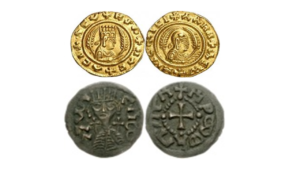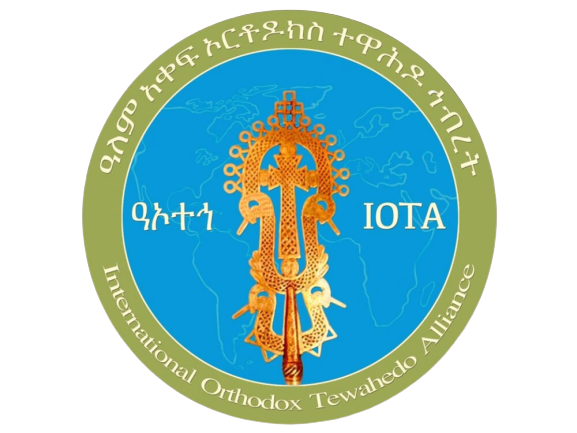-

Ancient Ethiopian coins bearing the sign of the cross The Ethiopian Orthodox Church (EOTC) is one of the ancient Christian churches in the world and Ethiopia the oldest state to adopt Christianity [1] [6] [9] [10]. EOTC traces Ethiopian Christianity back to the time of the holy Apostles and claims that Christianity reached the country in the 1st century C.E. Accordingly, the introduction of Christianity to Ethiopia can be traced to the meeting of the God-fearing Ethiopian eunuch, Simeon Bachos, with Philip the Deacon just a year after the resurrection of Jesus Christ and the subsequent conversion of the eunuch as recorded in the Holy Bible, in the Acts of the Apostles (Acts 8:26-38). In the King James Version and the Catholic Douay-Rheims Version of the Holy Bible, the Ethiopian says, “I believe that Jesus Christ is the Son of God”. Ethiopian tradition strongly asserts that Bachos returned to his homeland and preached the gospel and evangelized his countrymen. While one of the great Church father and historian, Eusebius, referred to the Ethiopian Eunuch as “the first fruit of Christianity in the whole world” [5], another renowned church Father and distinguished theologian, St. Irenaeus of Lyons, in his book Adversus haereses (Against the Heresies, an early anti-Gnostic theological work) 3:12:8 (180 AD), wrote about the Ethiopian eunuch stating “This man (Simeon Bachos the Eunuch) was also sent into the regions of Ethiopia, to preach what he had himself believed, that there was one God preached by the prophets, but that the Son of this (God) had already made (His) appearance in human flesh, and had been led as a sheep to the slaughter; and all the other statements which the prophets made regarding Him” [7]. It is also believed that the Ethiopian Eunuch was mentioned in Acts 13:1 with the name Simeon also called the Black [12]. Additional stories attest that Ethiopian Jewish pilgrims who had come for Passover were present in the Holy City of Jerusalem on the day of Pentecost (the birth of the Universal Church) when St. Peter was preaching to the mixed crowd, and they heard of good news and converted. In his Homily on Pentecost, St. John Chrysostom attested that among those who were present at Pentecost were Ethiopians.
Further, other accounts stated that St. Matthew the Apostle was allotted to preach Ethiopia and baptized a significant number of Ethiopians. Socrates of Constantinople listed Ethiopia as one of the regions preached by Matthew the Apostle. Church historian Nicephorus also mentioned that the apostle St. Matthew preached the Christian Gospel to modern-day Ethiopia [3]. The renowned early church historian, Rufinus of Tyre, also recorded a personal account similar to other early church historians. Ethiopian tradition holds that St. Matthew, St. Mark, and St. Bartholomew preached to Ethiopia in the 1st century C.E. Some non-Ethiopian stories mentioned that St. Matthew suffered martyrdom in Ethiopia. However, Ethiopian sources such as the Ethiopian Synaxarium [2] (The Bool of the Saints of The EOTC) made no mention of St. Matthew’s martyrdom in Ethiopia. Rather Ethiopians believe that they received Christianity without shedding apostolic blood. In this respect, several historical accounts recorded in numerous classical sources are in close agreement with the Ethiopian traditional accounts narration about the diffusion and permanent establishment of Christianity in the country. Indeed, many historians have been enthralled by the remarkably peaceful way Christianity has become the national religion in Ethiopia. For example, the American Historian and anthropologist, William Leo Hansberry, in his book Pillars in Ethiopian History, quoted Sir Francis B. Head, a British officer, and biographer, who aptly captured the spread of Christianity in Ethiopia as follows [6]:
“Never did the seed of Christian religion find more genial soil than when it first fell among the rugged mountains of Abyssinia”. There was, he further stated “no war to introduce it, no fanatic priesthood to oppose it, no bloodshed to disgrace it; its only argument was its truth; its only ornament was its simplicity; and around our religion, thus shining in its native luster, men flocked in peaceful humility, and hand in hand, joined cheerfully in doctrines which gave glory to God in the Highest, and announced on earth peace, goodwill toward men.”
The early church historian Eusebius similarly described the spread of Christianity in Ethiopia [4] [5] [6]: “Tradition says that he (the eunuch) who was the first of the Gentiles to receive from Philip by revelation the mysteries of the Divine word and was the first fruits of the faithful throughout the world, was also the first to return to his native land and preach the Gospel of the knowledge of God of the universe and the sojourn of our Savior which gives life to men, so that by him was actually fulfilled the prophecy which says, ‘Ethiopia shall stretch out her hands to God’ (Ps. 68:31). [4]”
Archaeological sources on the other hand and additional historical accounts indicate that Christianity became the official state religion in Ethiopia after the conversion of Emperor Ezana and his brother and Saizana of Axum during the first half of the 4th -century C.E.[1] [6] [9]
Two young Syrian brothers, Frementius (or Fremnatos) and Aedesius (Edesius), survivors of a shipwreck and captives were brought to the royal court of a powerful Axumixte kingdom, Emperor Ella Amida. Emperor Ella Amida treated the brothers with kindness, ordered that they be treated well and given a living quarter at his royal court. Shortly afterward, by displaying integrity, virtue, and wisdom, Frementius and Aedesius found favor in the sight of the Emperor. While Aedesius was appointed as a royal cupbearer, Frementius because of his knowledge of Greece was placed in charge of the royal records. Shortly before the Emperor’s death, the young brothers were set free to go back to their homeland whenever they wish to return. However, they stayed in Axum upon the widowed queen’s request to serve her as advisors and tutor her two sons Ezana and Saizana, who were designated by the Emperor as his heirs[i] [6], until the prince regents Ezana and Saizana became old enough to replace her as regent. During these years, the young brothers spread Christianity among the royal family and encouraged Christians to spread the gospel. Here, it is important to note that Ethiopian tradition tells that there were already a considerable number of Christian communities by the time Frementius and Aedesius arrived in Ethiopia. As tradition states, the brothers saw so many Ethiopians praying to the blessed Trinity and women wearing the sign of the cross on their foreheads and wondered much [6]. In addition to the previous references of the spread of Christianity in Ethiopia by Simeon Bachos, the Ethiopian Jews who were converted on the day of Pentecost, and the people baptized by St. Matthew, St. Mark, and St. Bartholomew, it is also worth noticing that Christian merchants form many foreign lands used to frequent the major entrepots of Ethiopia and that they were permitted to practice their faith, and that Ethiopia also served for many generations as a refuge for Christians who had been forced to flee from various parts of the Roman Empire to escape persecution imposed on them, from time to time, by imperial decrees and these Christians may have done their part in spreading the faith.
Later-on, Frementius traveled to Alexandria to request a bishop for Ethiopia from Archbishop St. Athanasius of Alexandria. He was consecrated by St. Athanasius as the first Bishop of Ethiopia returned to spread the faith. Upon his return, St. Frementius was warmly welcomed by the people and was given the name “Abba Salama, Kassate Berhan” meaning “Father of peace, Revealer of light”. St. Frementius finally succeeded in converting Emperor Ezana and his brother Saizana, and the Emperor declared Ethiopia to be a Christian state. Emperor Ezana and his brother Saizana were baptized with names signifying illumination, Abreha and Atsebha respectively which means “he lit the light” and “he brought the dawn” respectively. Aedesius later returned home to Tyre where he became a priest and shared his story, and that of his brother’s, with the Christian historian Rufinus Tyrannius of Aquila. Following the recognition of Ethiopia’s adoption of Christianity, St. Frementius structured the flourishing church, built the first Ethiopian Church “Mariam Tsion” or “The Church of Our Lady Mary of Zion” in Axum, and many others throughout the country [6]. After his death, St. Frementius was revered and celebrated as a saint [2].
Axum was one of the greatest civilizations and earliest states to develop a coin system to service its advanced international trade and affluent economy [1] [8] [9] [10]. After the birth of EOTC, Emperor Ezana became the first world leader who coined the earliest examples of Christian material culture from Ethiopia, the crosses [6]. After Christianity was declared the official state religion, a list of Christian emperors began to be minted on coins. Many of the coins feature Christian mottos and good wishes such as “He Conquers Through Christ”, “Mercy and Peace”, “Joy and Peace to the People”, “By the Grace of God”, “Thanks to be God” etc. Archeological discoveries unearthed several artifacts, pendants, and inscriptions among which is a Greek inscription that belonged to Ezana beginning by “in the faith of God and the power of the Father, the Son, and the Holy Ghost” that undoubtedly affirmed his embracing of Christianity.
Since then, Christianity became firmly rooted in the national conscience and culture of society. The church maintained ancient Christian faith and apostolic traditions for several centuries also became the rich storehouse of culture, history, literature, poetry, art, music, architecture, etc. Moreover, the church continuously and aptly guides the moral, spiritual, and intellectual lives of her devotees to date.
Part II will continue
(Dr. Fekerte Yitagesu)
References:
[1] Ben-Jochannan, Y., 1988, Africa: Mother of Western Civilization, Black Classic Press.
[2] Budge, E.A.W., Synaxarium: The Bool of the Saints of The Ethiopian Orthodox Tewahedo Church
[3] CATHOLICENCYCLOPEDIA, St. Matthias. , newadvent.org.
[4] Eusebius, 2015, The Ecclesiastical History, Aeterna Press.
[5] Eusebius, (1989-11-23), The History of the Church from Christ to Constantine. Translated by Williamson, G. (Rev. ed.). , Penguin.
[6] Hansberry, W.L., 1981, Pillars in Ethiopian History, Howard University Press.
[7] Irenaeus, S., Against Heresies (Book III, Chapter 12 no. 8), newadvent.org. .
[8] Irenaeus, S., 2012, in Böer, P., ed., Against Heresies, Veritatis Splendor Publications.
[9] Munro-Hay, S., 1991, Aksum: An African Civilization of Late Antiquity: Edinburgh, University Press.
[10] Munro-Hay, S., 2002, Ethiopia, the Unknown Land. IB Tauris. p. 20.
[11] Sozomenus, S.a., (1819-1893), Ecclesiastical Histories By Socrates Scholasticus, in Schaff, P., ed., Grand Rapids, MI: Christian Classics Ethereal Library.
[12] Yohannes, P., 1988, Filsata: the feast of the Assumption of the Virgin Mary and the Mariological tradition of the Ethiopian Orthodox Tewahedo Church (PhD). New Jersey, Princeton Theological Seminary.
[i][i] According to Ethiopian tradition, the two brothers Ezana and Saezana were designated by their father as his heirs and were enthroned as co-sovereigns. Despite the joint tenancy, Ethiopian traditions record that the brother’s relationships were remarkably peaceful in every aspect. However, modern historians tend to emphasize the influence, achievement, and role of Emperor Ezana, and write as if he alone had been ruling the kingdom.
Accordion content
